



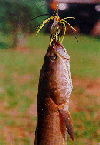 Spinnerbait!
Spinnerbait!
by Chris Tan Here I was, under the sweltering sun. It was past lunchtime. I was hungry. But there was no way I was going to stop fishing. I had just caught two haruan and one bujuk. (Bujuks belong to the same family as haruans and tomans). Within 45 minutes, I caught another five haruan. It was one of those days. It started with nothing, but ended with a sudden catch. I had by chance, seen from the air, a swampy looking forest with channels running through. It held possibilities for some good haruan fishing. For months I had driven around the area (south of Puchong, Selangor), searching for this swamp. After an early morning start, and two hours later, I found it. But to my disappointment, I spent two unsuccessful hours there. With such bad fishing I decided to leave. My drive back to town went through an oil palm plantation. Beside the sun baked dirt road was a small canal. Overgrown with weeds and aquatic plants, it was perfect haruan territory. My first cast brought in a nice sized bujuk. An hour and six haruan later I happily headed for the nearest town for a very late lunch. Convention would have you thinking that I was using the standard haruan bait, frogs. But I used an artificial lure called the spinnerbait. I have found it to be a very effective fish catcher. When frogs and spinnerbaits have been fished together, the spinnerbait has pulled in the haruan in greater numbers. In fact all the biggest fish were landed by using the spinnerbait. The spinnerbait has been appearing in Malaysian tackle shops in the past year. This lure is widely used in United States for many years for bass fishing. It is also a popular lure for bass and other fish in Japan, South Africa and Europe. Although we do not have bass in Malaysia, we do have our haruans. Spinnerbait has caught other fish too, sebarau, toman, bujuk and even salt water grouper. 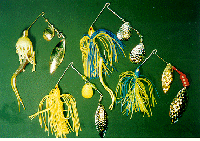 It is a peculiar looking lure . When I first saw it in catalogues I
wondered how any fish would bite on it, since it does not look like any
thing a fish would eat. Through personal experience, my opinion of the
lures capabilities has changed dramatically. As you can see in the pictures
the lure has a hook with a colourful lead head, which is covered with a
skirt made of rubber, silicone, feathers or a plastic worm. The lead head
is attached to a thick wire to the tow point, bending back 90 degrees
leading to a swivel and spinner. The more expensive spinnerbaits are made
of better materials, like chemically sharpened hooks, silicone skirts,ball
bearing swivels and better quality paint work. A good blade and swivel
should revolve when blown upon lightly.
It is a peculiar looking lure . When I first saw it in catalogues I
wondered how any fish would bite on it, since it does not look like any
thing a fish would eat. Through personal experience, my opinion of the
lures capabilities has changed dramatically. As you can see in the pictures
the lure has a hook with a colourful lead head, which is covered with a
skirt made of rubber, silicone, feathers or a plastic worm. The lead head
is attached to a thick wire to the tow point, bending back 90 degrees
leading to a swivel and spinner. The more expensive spinnerbaits are made
of better materials, like chemically sharpened hooks, silicone skirts,ball
bearing swivels and better quality paint work. A good blade and swivel
should revolve when blown upon lightly.
But why bother with spinnerbaits, as they cost at least 30 times more than a frog. Well, I do not have to go through the trouble of purchasing frogs whenever I go fishing. Deciding how many frogs to buy is a hassle too. In the long run, using a spinnerbait is cheaper as it is reusable. Clipping on a lure is easier than tying and baiting a frog. And you can go on fishing with the same lure after catching a fish, without rebaiting. In fact, I have caught in market value, far more haruan than I have spent purchasing these lures. But my main reason for using the spinnerbait is that for me it catches more haruan than using frogs for bait. Positive hook ups are one of the reasons that spinnerbaits are more effective. With frogs, the hooks need to be embedded to present a weedless bait. Often the haruan drops the frog before the hook is set. Or on the strike the hook does not catch in the mouth. Munching up the frog and spitting out the hook is not uncommon either. Overall, the average positive hooksets for frogs is 50% or less, whereas the spinnerbait normally gives 90% or more. Although spinnerbaits are weedless due to the hook being protected by the wire from the tow point and the spinner, it is best used in clear water along weed lines or in areas with patches of weeds and water lilies, where other lures would get snagged on weeds and grass. In areas withcontinuous dense weeds and aquatic vegetation, frogs and plastic worms are the most effective as the spinner of the spinnerbait cannot spin in such conditions. 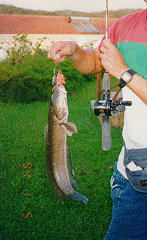 Last year there was a chap watching me fish with a spinnerbait. He was
rather sceptical about it. He offered to show me a small pond with haruan.
On the first cast with a mini-spinnerbait I caught a haruan. Within the
next 15 minutes I caught two more. He was so impressed that on the spot he
bought a spinner bait off me. A few months later, I met him again. Now he
mainly uses spinnerbait. The local tackle shop owner wonders why he does
not buy frogs now, and the reply is that they are not needed.
Last year there was a chap watching me fish with a spinnerbait. He was
rather sceptical about it. He offered to show me a small pond with haruan.
On the first cast with a mini-spinnerbait I caught a haruan. Within the
next 15 minutes I caught two more. He was so impressed that on the spot he
bought a spinner bait off me. A few months later, I met him again. Now he
mainly uses spinnerbait. The local tackle shop owner wonders why he does
not buy frogs now, and the reply is that they are not needed.
There are many different variations to a spinnerbait. Starting with the blades, it comes in different shapes and sizes. There three common shapes: colorado, indiana and willowleaf. The colorado is a big broad shaped blade, whereas the willowleaf blade is longer and narrower. The indiana blade comes between these two. The colorado blade produces a heavy pulsating throb, while the willowleaf blade spins faster with a tighter vibration. Spinnerbaits also come with twin blades. There are some giant models that even have three blades. There is another version called the buzz bait. The blade is shaped differently to make it run on the surface. It is good for running on the surface where there are plenty of grassy snags just below the surface, and when you want to make heaps of noise, it splashes and buzzes attractively. The blades are normally chromed, gold or painted with fluorescent colours. The skirts and jig heads are available in numerous colours and mixtures of colours. You can modify the spinnerbait colours by painting the blade and jig head. Extra skirts can be purchased to make your own patterns. Blades can be interchanged to suit your needs. 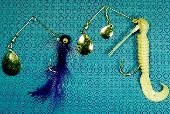 Different types of spinnerbaits have different actions. Thus it is wise to
find the most suitable lure for that day's conditions. There was a day when
I went to a nearby pond to test a new rod. I cast at one prospective
looking corner, frequently changing lures - all spinnerbaits, from small
ones to big ones, rubber skirts to feathers. About thirty casts later, much
to my surprise and delight, I was rewarded with a big haruan, well in
excess of a kilo. It had decided to hit a medium sized black spinnerbait
with a small colorado blade. It could have been any one difference - the
vibration, size or colour that attracted the fish. So do not hesitate to
change lures if you are not getting strikes.
Different types of spinnerbaits have different actions. Thus it is wise to
find the most suitable lure for that day's conditions. There was a day when
I went to a nearby pond to test a new rod. I cast at one prospective
looking corner, frequently changing lures - all spinnerbaits, from small
ones to big ones, rubber skirts to feathers. About thirty casts later, much
to my surprise and delight, I was rewarded with a big haruan, well in
excess of a kilo. It had decided to hit a medium sized black spinnerbait
with a small colorado blade. It could have been any one difference - the
vibration, size or colour that attracted the fish. So do not hesitate to
change lures if you are not getting strikes.
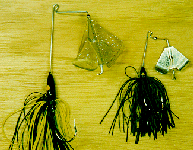 On another occasion, in a shallow pond, I had a nudge on my
mini-spinnerbait. I saw a haruan closely following it. On the second cast I
saw it follow the lure again. Subsequent casts were also unsuccessful. My
friend came along and between us the haruan suffered a barrage of different
spinnerbaits, big and small. It was clear the fish was not interested in
any of the lures we offered, as it had disappeared.. My friend gave up and
moved off. The only lure I had not tried so far was the buzz bait. For one
last try, I clipped it on. It whirred and splashed on the surface. Suddenly
the haruan exploded beneath it and took off with the lure firmly embedded
in its jaw. Why that particular lure? Perhaps it was the extreme noise
aggravating it to strike.
On another occasion, in a shallow pond, I had a nudge on my
mini-spinnerbait. I saw a haruan closely following it. On the second cast I
saw it follow the lure again. Subsequent casts were also unsuccessful. My
friend came along and between us the haruan suffered a barrage of different
spinnerbaits, big and small. It was clear the fish was not interested in
any of the lures we offered, as it had disappeared.. My friend gave up and
moved off. The only lure I had not tried so far was the buzz bait. For one
last try, I clipped it on. It whirred and splashed on the surface. Suddenly
the haruan exploded beneath it and took off with the lure firmly embedded
in its jaw. Why that particular lure? Perhaps it was the extreme noise
aggravating it to strike.
The spinnerbait is easily used. The most straight forward is a steady retrieve past any likely looking structure or along the edge of a weedline. The depth is controlled by delaying the start of the retrieve, and the speed. But be careful as the blades rotate as the spinnerbait sinks, giving off vibration and flashes. There have been times I have had big fish strike on the fall before I started the retrieve. So watch the line carefully. I have also had the spinnerbait taken on a steady retrieve, without feeling a bite at all. The only indication was the line moving sideways. Striking, I found there was a fish on the lure. But normally the strikes come hard with an immediate hookup. You can also retrieve it like a yo-yo to bounce the bottom, by lifting the rod tip, then retrieving on the drop. Bumping the lure along the bottom is also very effective. The advantage of this lure over others, is that its hook rides upwards, making it virtually snagless. It also can be jigged vertically. You can also fish holes among weeds and water lilies by commencing the retrieve just before it hits the surface. Then dragging it over the vegetation, upon reaching the hole,allow it to flutter down like a helicopter before recommencing the retrieve. If you find the fish are striking short (which is rare), adding a trailerhook helps. Sweetening the spinnerbait with a strip of meat or a worm is quite effective. Using the artificial scents too has caught fish. The speed of retrieve can easily be varied by changing the angle of the wire arms. Bringing the arms together and a faster retrieve is possible with less drag. Or for a slow retrieve, open it wide and the throbbing of the spinners can still be felt on a very slow retrieve. Twin blades create more flash and noise, but twin blades cause more drag in the water, requiring a slower retrieve. The drag causes it to run shallower than a single blade model. However, the single bladed spinnerbait gives out a louder, more positive throb, and having less drag it can run deeper and be cast further. Always ensure that you can feel the throb and pulse of the spinner bait as it is retrieved, as that is what attracts the fish to it. And if you do like fishing at night, give the spinnerbait a try. It works. |